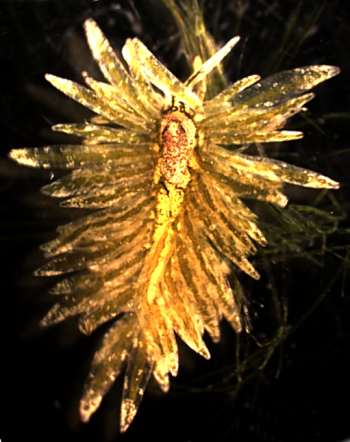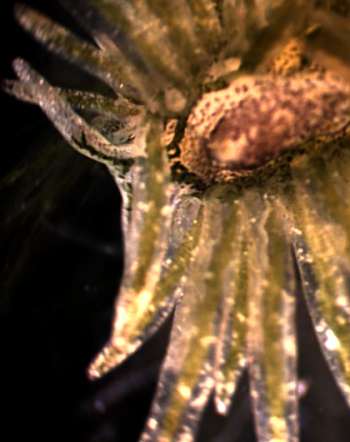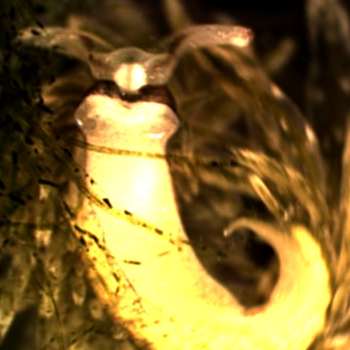

Placida kingstoni
Thompson, 1977
Order: SACOGLOSSA
Superfamily: LIMAPONTIOIDEA
Family: Limapontiidae
DISTRIBUTION
Caribbean
PHOTO
In shallow water near the shore of Tampa Bay, Florida by Nick Curtis, January 2004. On Bryopsis. Approx 2 cm long. Photo: Julie A. Schwartz
The body wall is translucent with scattered brown spots, and sometimes white spots as well. The viscera show through the skin. The cerata are long. The ceratal wall is translucent clear with some scattered white speckling and a brown tip. There is an unbranched green duct of the digestive gland in each ceras. On the head, a dark green branch of the digestive gland runs along each side giving off ducts to each of the anterior cerata and to the rhinophore on its side. On the ventral side of the rhinophore the basal half is clearly enrolled, but the upper half forms a solid tapering cylinder [see photo]. One characteristic behaviour of this species is that the cerata pulsate. Grows to approx 20mm long.
Originally described from Jamaica, it has been reported from Florida by Kathe Jensen (1981) who studied its feeding on Bryopsis plumosa. She describes a strange behaviour in which the slug sucks the cell sap out of the algal filaments and then it returns back into the algal filament before being resucked into the slug again. This process can be repeated two or three times before eventually being pumped into the stomach.
References:
• Jensen, K.R. (1981) Observations on feeding methods in some Florida ascoglossans. Journal of Molluscan Studies, 47: 190-199.
• Thompson, T.E. (1977) Jamaican opisthobranch molluscs I. Journal of Molluscan Studies, 43(2): 93-139, pls.1-3.
Rudman, W.B., 2004 (January 22) Placida kingstoni Thompson, 1977. [In] Sea Slug Forum. Australian Museum, Sydney. Available from http://www.seaslugforum.net/find/placking
Related messages
Placida kingstoni? from Florida
January 25, 2004
From: Julie A. Schwartz


Dear Dr. Rudman,
This slug crawled out of some Bryopsis that was collected from a rock substrate near the shore of Tampa Bay, Florida by Nick Curtis about one week ago. It is approximately 2 cm in length and has one pair of rhinophores. The cerata appear to pulsate, but not in any type of synchronized way. While handling him one of the cerata came off and a whitish liquid was released. The pictures were very difficult to get because the slug was quite active. Hopefully, they will show enough detail to be able to identify him.
Best Regards,
Julie A. Schwartz
jschwart@mail.cas.usf.edu
Schwartz, J.A., 2004 (Jan 25) Placida kingstoni? from Florida. [Message in] Sea Slug Forum. Australian Museum, Sydney. Available from http://www.seaslugforum.net/find/11997
Dear Julie,
This is a sacoglossan sea slug. I am pretty sure it is Placida kingstoni, which was described from Jamaica, but has been reported from Florida by Kathe Jensen (1981) who studied its feeding on Bryopsis plumosa. She describes a strange behaviour in which the slug sucks the cell sap out of the algal filaments and then it returns back into the algal filament before being resucked into the slug again. This process can be repeated two or three times before eventually being pumped into the stomach. Tom Thompson (1977), in his original description of the species, notes that it pulsates its cerata as you describe. Many sacoglossans produce a white viscous secretion from skin glands when disturbed.
One point of interest I can see in your photo, which I have posted alongside, of the underside of the animal is the shape of the rhinophores. I can can clearly see that the basal half is enrolled, much like the rhinophores of Elysia, but the upper half of the rhinophores is a solid tapering tube. Thompson (1977) described exactly this type of rhinophore. One character of the genus Placida is that the rhinophores are enrolled, so I guess this species just squeaks in on this character. As far as I know yours are the first published photos of this species.
Best wishes
Bill Rudman
